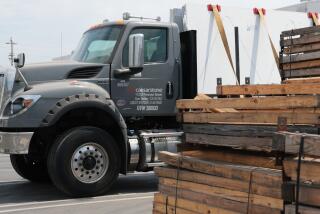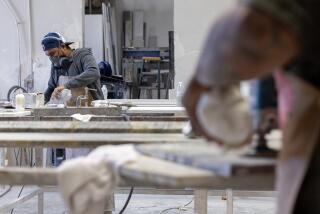Marble Making Is West Virginia’s Well-Kept Secret
- Share via
PADEN CITY, W.Va. — Roger Howdyshell would rather keep quiet about the product he manufactures by the millions in northern West Virginia.
But two steps inside an old wooden warehouse, the mystery ends.
Marbles are everywhere. The colorful spheres of glass are perhaps West Virginia’s best kept secret.
Howdyshell leaves containers of extras piled high in his office and others stuffed in bottles for doorstops. Orange and white ones replace the numbers on his wall clock.
And with three of the nation’s five marble factories, West Virginia could well be called the marble capital of America.
The marble industry is nothing new to the Mountain State. Ever since marble-making started in the 1920s, West Virginia always has housed most of the nation’s factories.
Howdyshell, the 63-year-old owner of Marble King Inc., says an abundance of glass, natural gas and cheap labor attracted the earliest marble-makers to West Virginia. At one time the state had seven factories churning out the colorful spheres, mostly for children’s games.
But times have changed for America’s marble manufacturers.
Fewer Glass Companies
Many of the prized West Virginia glass companies have shut down, forcing marble-makers like Howdyshell to turn to other states such as New Jersey or Pennsylvania for glass. Bogard Co., formerly based in Cairo, W. Va., recently gathered its marbles and headed to Reno, Ohio.
And fewer people today are playing Chinese Checkers, a popular family pastime during the Depression years, Howdyshell said.
However, nothing has hurt the nation’s marble industry more than foreign competition.
Countries such as Mexico, Taiwan, and Korea stepped into the marble scene during the 1970s and now have cornered the retail market in America. Foreign companies are the main suppliers of the marbles children reach for in toy stores throughout the nation.
“Ours just can’t be cheaper than theirs,” Howdyshell said.
So U.S. marble makers have had to depend on other markets. Although they still produce game marbles, U.S. factories sell millions of marbles to industries all over the world that use the glass spheres for everything from filters to ball bearings.
Floral Arrangements
“We never know what the use is going to be of these things,” Howdyshell said, adding that recently he has produced huge quantities of pink marbles for florists who use them to decorate floral arrangements.
Although there is no official tabulation of marble production--West Virginia officials say they have no records because they do not tax the industry--the five American factories that still do business seem to be doing just fine.
“In the past four years it’s been getting better,” said Louis Moore, general manager of Vitro Agate in Parkersburg. Vitro Agate, a division of Paris Manufacturing in Maine, is the only marble factory not owned by an individual. The other West Virginia marble factory is Champion Agate in Pennsboro in Ritchie County.
Only two U.S. factories produce marbles outside of West Virginia. One is located in Reno, Ohio, and the other in Ottawa, Ill. Moore, who has been in the business 47 years, says he produces “several million” marbles a year. He says he has it down to a science.
“We’re making basically the same marble we were making years ago,” said Moore. “It’s just like an old song.”
Tricks of the Trade
Making the perfect marble is as simple as the product looks, although there are a few tricks involved that only the old-timers know.
“We try to make them as round as we can and as pretty as we can,” said Howdyshell, who has been in the business since 1940.
Marble King employs 20 to 30 people to make about 1 million marbles a day year-round, Howdyshell said.
Every day, the factory uses about eight tons of scrap lead glass--some colored, some clear--which is thrown into a 2,400-degree fire.
The molten glass drips through a circular hole and is cut into a silver-dollar shape. Squeezed between two metal rods, ten thousand turns later the glass forms into a ball in sizes that range from 3/8 inch to 1 1/2 inches.
Any mistakes go right back into the fire: Marble making is one industry that doesn’t waste a thing.
Howdyshell can produce about 100 marbles a minute. But packaging goes as fast as 3,000 a minute, so he likes to keep 2 million extras in each of his various storage bins.
With coloring dyes, Howdyshell can produce as many as 105 different shades, including lemon, super jade, super peach, lavender, and amber.
Marble owners realize their industry could be a major tourist attraction in the state.
But they don’t like to encourage visitors.
Howdyshell is just as content to spend a quiet day in the factory, jiggling a few spare marbles in his pants pocket.
More to Read
Inside the business of entertainment
The Wide Shot brings you news, analysis and insights on everything from streaming wars to production — and what it all means for the future.
You may occasionally receive promotional content from the Los Angeles Times.










